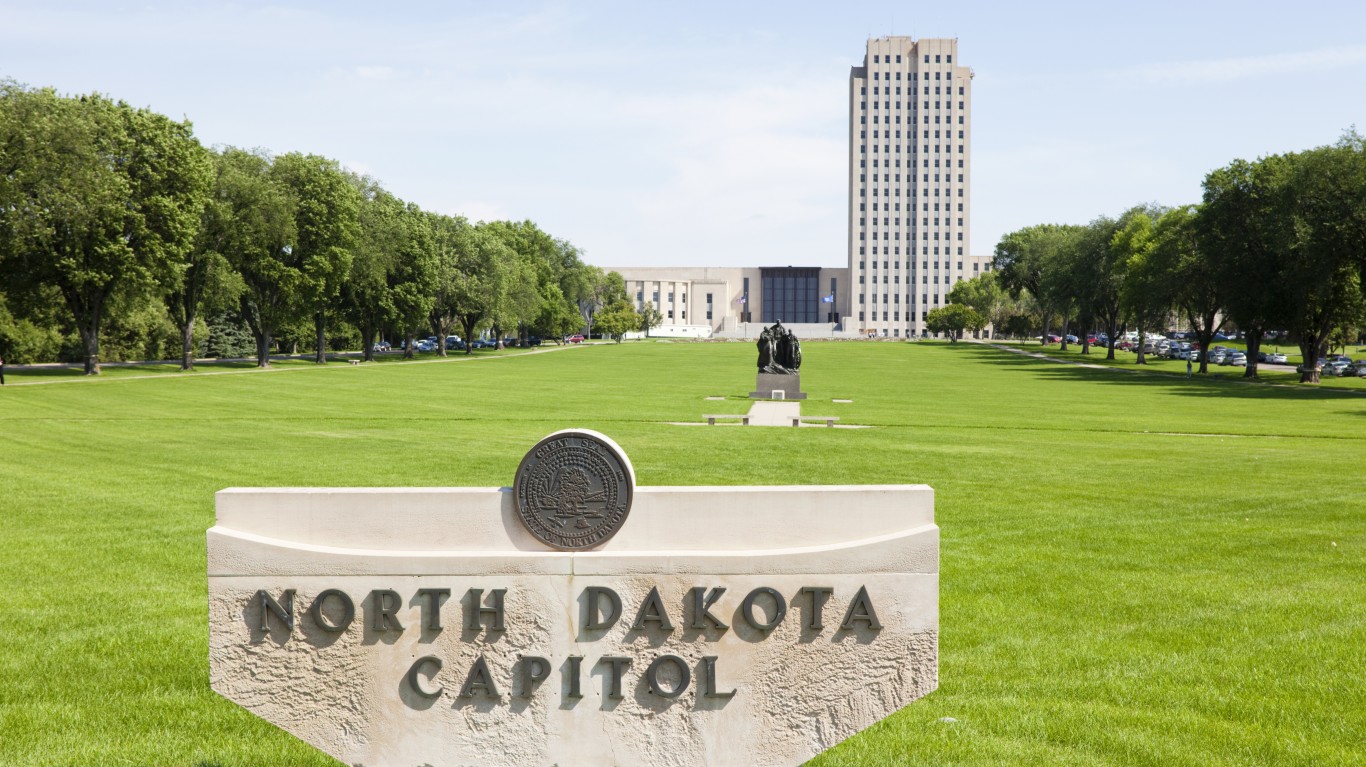Special Report
This is the City in Every State Where COVID-19 is Growing the Fastest

Published:

The U.S. has reported more than 32.4 million confirmed COVID-19 cases as of May 13. There have been more than 577,000 reported deaths from COVID-19-related causes — the highest death toll of any country.
The extent of the spread of the novel coronavirus continues to vary considerably from state to state, and from city to city. Even as the number of daily new cases is flattening or even declining in some parts of the country, it is surging at a growing rate in others.
Nationwide, the number of new cases is growing at a steady rate. There were an average of 13.4 daily new coronavirus cases per 100,000 Americans in the week ending May 13, essentially unchanged from the week prior, when there were an average of 15.1 daily new coronavirus cases per 100,000 people.
Metropolitan areas with a high degree of mobility and a large population may be particularly vulnerable to outbreaks. While science and medical professionals are still studying how exactly the virus spreads, experts agree that outbreaks are more likely to occur in group settings where large numbers of people routinely have close contact with one another. Cities with high concentrations of dense spaces such as colleges, correctional facilities, and nursing homes are particularly at risk.
The city with the highest seven-day average of new daily COVID-19 cases per capita is in Maine. In the Lewiston-Auburn, ME, metro area, there were an average of 53.7 daily new coronavirus cases per 100,000 residents in the week ending May 13, the most of any U.S. metro area. Other cities where COVID-19 is growing the fastest include Muskegon, MI; Pueblo, CO; and Bend, OR.
To determine the metropolitan area in each state where COVID-19 is growing the fastest, 24/7 Wall St. compiled and reviewed data from state and local health departments. We ranked metropolitan areas according to the average number of new daily COVID-19 cases per 100,000 residents in the seven days ending May 13. Data was aggregated from the county level to the metropolitan area level using boundary definitions from the U.S. Census Bureau. Population data used to adjust case and death totals came from the U.S. Census Bureau’s 2019 American Community Survey and are five-year estimates. Unemployment data is from the Bureau of Labor Statistics and is seasonally adjusted.

Alabama: Daphne-Fairhope-Foley
Avg. new daily cases in Daphne in week ending May 13: 9.8 per 100,000
Avg. new daily cases in Daphne in week ending May 6: 8.1 per 100,000
COVID-19 cases in Daphne as of May 13: 21,154 (9,939.4 per 100,000)
Peak pandemic unemployment in Daphne: 16.3% (April 2020)
Daphne population: 212,830 (133.9 people per sq. mi.)

Alaska: Fairbanks
Avg. new daily cases in Fairbanks in week ending May 13: 28.1 per 100,000
Avg. new daily cases in Fairbanks in week ending May 6: 58.4 per 100,000
COVID-19 cases in Fairbanks as of May 13: 7,878 (7,951.8 per 100,000)
Peak pandemic unemployment in Fairbanks: 11.4% (April 2020)
Fairbanks population: 99,072 (13.5 people per sq. mi.)
These are all the counties in Alaska where COVID-19 is slowing (and where it’s still getting worse).

Arizona: Phoenix-Mesa-Chandler
Avg. new daily cases in Phoenix in week ending May 13: 11.9 per 100,000
Avg. new daily cases in Phoenix in week ending May 6: 11.9 per 100,000
COVID-19 cases in Phoenix as of May 13: 594,420 (12,483.6 per 100,000)
Peak pandemic unemployment in Phoenix: 12.8% (April 2020)
Phoenix population: 4,761,603 (326.9 people per sq. mi.)

Arkansas: Jonesboro
Avg. new daily cases in Jonesboro in week ending May 13: 9.5 per 100,000
Avg. new daily cases in Jonesboro in week ending May 6: 8.9 per 100,000
COVID-19 cases in Jonesboro as of May 13: 16,627 (12,669.1 per 100,000)
Peak pandemic unemployment in Jonesboro: 9.3% (April 2020)
Jonesboro population: 131,241 (89.5 people per sq. mi.)

California: Modesto
Avg. new daily cases in Modesto in week ending May 13: 13.1 per 100,000
Avg. new daily cases in Modesto in week ending May 6: 14.6 per 100,000
COVID-19 cases in Modesto as of May 13: 62,058 (11,424.6 per 100,000)
Peak pandemic unemployment in Modesto: 17.4% (April 2020)
Modesto population: 543,194 (363.4 people per sq. mi.)

Colorado: Pueblo
Avg. new daily cases in Pueblo in week ending May 13: 49.7 per 100,000
Avg. new daily cases in Pueblo in week ending May 6: 52.6 per 100,000
COVID-19 cases in Pueblo as of May 13: 18,566 (11,185.6 per 100,000)
Peak pandemic unemployment in Pueblo: 11.8% (April 2020)
Pueblo population: 165,982 (69.6 people per sq. mi.)

Connecticut: New Haven-Milford
Avg. new daily cases in New Haven in week ending May 13: 17.1 per 100,000
Avg. new daily cases in New Haven in week ending May 6: 24.1 per 100,000
COVID-19 cases in New Haven as of May 13: 90,949 (10,606.1 per 100,000)
Peak pandemic unemployment in New Haven: 9.5% (July 2020)
New Haven population: 857,513 (1,418.5 people per sq. mi.)

Delaware: Dover
Avg. new daily cases in Dover in week ending May 13: 22.0 per 100,000
Avg. new daily cases in Dover in week ending May 6: 31.1 per 100,000
COVID-19 cases in Dover as of May 13: 17,722 (10,029.5 per 100,000)
Peak pandemic unemployment in Dover: 17.3% (May 2020)
Dover population: 176,699 (301.4 people per sq. mi.)

Florida: Cape Coral-Fort Myers
Avg. new daily cases in Cape Coral in week ending May 13: 26.1 per 100,000
Avg. new daily cases in Cape Coral in week ending May 6: 32.4 per 100,000
COVID-19 cases in Cape Coral as of May 13: 71,399 (9,681.6 per 100,000)
Peak pandemic unemployment in Cape Coral: 15.1% (April 2020)
Cape Coral population: 737,468 (940.0 people per sq. mi.)

Georgia: Augusta-Richmond County, GA-SC
Avg. new daily cases in Augusta in week ending May 13: 12.0 per 100,000
Avg. new daily cases in Augusta in week ending May 6: 13.4 per 100,000
COVID-19 cases in Augusta as of May 13: 67,871 (11,319.1 per 100,000)
Peak pandemic unemployment in Augusta: 10.9% (April 2020)
Augusta population: 599,616 (172.3 people per sq. mi.)

Hawaii: Kahului-Wailuku-Lahaina
Avg. new daily cases in Kahului in week ending May 13: 9.1 per 100,000
Avg. new daily cases in Kahului in week ending May 6: 8.6 per 100,000
COVID-19 cases in Kahului as of May 13: 4,454 (2,683.5 per 100,000)
Peak pandemic unemployment in Kahului: 34.8% (April 2020)
Kahului population: 165,979 (142.9 people per sq. mi.)
These are all the counties in Hawaii where COVID-19 is slowing (and where it’s still getting worse).

Idaho: Coeur d’Alene
Avg. new daily cases in Coeur d’Alene in week ending May 13: 16.4 per 100,000
Avg. new daily cases in Coeur d’Alene in week ending May 6: 15.0 per 100,000
COVID-19 cases in Coeur d’Alene as of May 13: 18,051 (11,473.9 per 100,000)
Peak pandemic unemployment in Coeur d’Alene: 17.2% (April 2020)
Coeur d’Alene population: 157,322 (126.5 people per sq. mi.)
These are all the counties in Idaho where COVID-19 is slowing (and where it’s still getting worse).
Illinois: Danville
Avg. new daily cases in Danville in week ending May 13: 37.7 per 100,000
Avg. new daily cases in Danville in week ending May 6: 25.7 per 100,000
COVID-19 cases in Danville as of May 13: 9,575 (12,344.8 per 100,000)
Peak pandemic unemployment in Danville: 18.4% (April 2020)
Danville population: 77,563 (86.3 people per sq. mi.)

Indiana: Michigan City-La Porte
Avg. new daily cases in Michigan City in week ending May 13: 35.0 per 100,000
Avg. new daily cases in Michigan City in week ending May 6: 33.9 per 100,000
COVID-19 cases in Michigan City as of May 13: 11,928 (10,828.5 per 100,000)
Peak pandemic unemployment in Michigan City: 21.6% (April 2020)
Michigan City population: 110,154 (184.1 people per sq. mi.)

Iowa: Davenport-Moline-Rock Island, IA-IL
Avg. new daily cases in Davenport in week ending May 13: 21.3 per 100,000
Avg. new daily cases in Davenport in week ending May 6: 21.4 per 100,000
COVID-19 cases in Davenport as of May 13: 41,291 (10,832.6 per 100,000)
Peak pandemic unemployment in Davenport: 16.0% (April 2020)
Davenport population: 381,175 (167.9 people per sq. mi.)
These are all the counties in Iowa where COVID-19 is slowing (and where it’s still getting worse).

Kansas: Wichita
Avg. new daily cases in Wichita in week ending May 13: 9.3 per 100,000
Avg. new daily cases in Wichita in week ending May 6: 9.5 per 100,000
COVID-19 cases in Wichita as of May 13: 69,923 (10,965.0 per 100,000)
Peak pandemic unemployment in Wichita: 18.2% (April 2020)
Wichita population: 637,690 (153.7 people per sq. mi.)
These are all the counties in Kansas where COVID-19 is slowing (and where it’s still getting worse).

Kentucky: Owensboro
Avg. new daily cases in Owensboro in week ending May 13: 14.7 per 100,000
Avg. new daily cases in Owensboro in week ending May 6: 14.9 per 100,000
COVID-19 cases in Owensboro as of May 13: 12,513 (10,561.5 per 100,000)
Peak pandemic unemployment in Owensboro: 15.5% (April 2020)
Owensboro population: 118,477 (131.9 people per sq. mi.)

Louisiana: Lafayette
Avg. new daily cases in Lafayette in week ending May 13: 14.9 per 100,000
Avg. new daily cases in Lafayette in week ending May 6: 12.3 per 100,000
COVID-19 cases in Lafayette as of May 13: 47,945 (9,786.4 per 100,000)
Peak pandemic unemployment in Lafayette: 13.9% (April 2020)
Lafayette population: 489,914 (143.7 people per sq. mi.)

Maine: Lewiston-Auburn
Avg. new daily cases in Lewiston in week ending May 13: 53.7 per 100,000
Avg. new daily cases in Lewiston in week ending May 6: 52.2 per 100,000
COVID-19 cases in Lewiston as of May 13: 7,819 (7,266.6 per 100,000)
Peak pandemic unemployment in Lewiston: 10.3% (July 2020)
Lewiston population: 107,602 (230.0 people per sq. mi.)
These are all the counties in Maine where COVID-19 is slowing (and where it’s still getting worse).

Maryland: Hagerstown-Martinsburg, MD-WV
Avg. new daily cases in Hagerstown in week ending May 13: 20.0 per 100,000
Avg. new daily cases in Hagerstown in week ending May 6: 23.8 per 100,000
COVID-19 cases in Hagerstown as of May 13: 27,899 (9,853.2 per 100,000)
Peak pandemic unemployment in Hagerstown: 12.0% (April 2020)
Hagerstown population: 283,147 (280.9 people per sq. mi.)

Massachusetts: Springfield
Avg. new daily cases in Springfield in week ending May 13: 14.6 per 100,000
Avg. new daily cases in Springfield in week ending May 6: 20.4 per 100,000
COVID-19 cases in Springfield as of May 13: 63,017 (9,009.1 per 100,000)
Peak pandemic unemployment in Springfield: 17.1% (June 2020)
Springfield population: 699,480 (379.4 people per sq. mi.)

Michigan: Muskegon
Avg. new daily cases in Muskegon in week ending May 13: 52.3 per 100,000
Avg. new daily cases in Muskegon in week ending May 6: 75.4 per 100,000
COVID-19 cases in Muskegon as of May 13: 15,300 (8,828.8 per 100,000)
Peak pandemic unemployment in Muskegon: 29.8% (April 2020)
Muskegon population: 173,297 (347.1 people per sq. mi.)
Minnesota: St. Cloud
Avg. new daily cases in St. Cloud in week ending May 13: 27.7 per 100,000
Avg. new daily cases in St. Cloud in week ending May 6: 34.0 per 100,000
COVID-19 cases in St. Cloud as of May 13: 27,798 (13,998.3 per 100,000)
Peak pandemic unemployment in St. Cloud: 9.4% (May 2020)
St. Cloud population: 198,581 (113.4 people per sq. mi.)

Mississippi: Gulfport-Biloxi
Avg. new daily cases in Gulfport in week ending May 13: 5.6 per 100,000
Avg. new daily cases in Gulfport in week ending May 6: 7.5 per 100,000
COVID-19 cases in Gulfport as of May 13: 36,916 (8,957.7 per 100,000)
Peak pandemic unemployment in Gulfport: 22.3% (April 2020)
Gulfport population: 412,115 (186.0 people per sq. mi.)

Missouri: St. Louis, MO-IL
Avg. new daily cases in St. Louis in week ending May 13: 11.6 per 100,000
Avg. new daily cases in St. Louis in week ending May 6: 14.0 per 100,000
COVID-19 cases in St. Louis as of May 13: 287,149 (10,236.3 per 100,000)
Peak pandemic unemployment in St. Louis: 11.6% (April 2020)
St. Louis population: 2,805,190 (356.7 people per sq. mi.)

Montana: Great Falls
Avg. new daily cases in Great Falls in week ending May 13: 20.2 per 100,000
Avg. new daily cases in Great Falls in week ending May 6: 17.6 per 100,000
COVID-19 cases in Great Falls as of May 13: 9,041 (11,076.3 per 100,000)
Peak pandemic unemployment in Great Falls: 12.6% (April 2020)
Great Falls population: 81,625 (30.3 people per sq. mi.)

Nebraska: Omaha-Council Bluffs, NE-IA
Avg. new daily cases in Omaha in week ending May 13: 12.6 per 100,000
Avg. new daily cases in Omaha in week ending May 6: 15.0 per 100,000
COVID-19 cases in Omaha as of May 13: 115,956 (12,444.6 per 100,000)
Peak pandemic unemployment in Omaha: 10.2% (April 2020)
Omaha population: 931,779 (214.2 people per sq. mi.)

Nevada: Las Vegas-Henderson-Paradise
Avg. new daily cases in Las Vegas in week ending May 13: 14.3 per 100,000
Avg. new daily cases in Las Vegas in week ending May 6: 14.3 per 100,000
COVID-19 cases in Las Vegas as of May 13: 247,186 (11,328.4 per 100,000)
Peak pandemic unemployment in Las Vegas: 34.2% (April 2020)
Las Vegas population: 2,182,004 (276.5 people per sq. mi.)
These are all the counties in Nevada where COVID-19 is slowing (and where it’s still getting worse).

New Hampshire: Manchester-Nashua
Avg. new daily cases in Manchester in week ending May 13: 15.4 per 100,000
Avg. new daily cases in Manchester in week ending May 6: 18.6 per 100,000
COVID-19 cases in Manchester as of May 13: 35,425 (8,576.8 per 100,000)
Peak pandemic unemployment in Manchester: 17.5% (April 2020)
Manchester population: 413,035 (471.4 people per sq. mi.)

New Jersey: Vineland-Bridgeton
Avg. new daily cases in Vineland in week ending May 13: 25.4 per 100,000
Avg. new daily cases in Vineland in week ending May 6: 16.0 per 100,000
COVID-19 cases in Vineland as of May 13: 16,850 (11,092.4 per 100,000)
Peak pandemic unemployment in Vineland: 17.5% (June 2020)
Vineland population: 151,906 (314.1 people per sq. mi.)

New Mexico: Farmington
Avg. new daily cases in Farmington in week ending May 13: 33.3 per 100,000
Avg. new daily cases in Farmington in week ending May 6: 27.9 per 100,000
COVID-19 cases in Farmington as of May 13: 14,973 (11,835.0 per 100,000)
Peak pandemic unemployment in Farmington: 14.5% (July 2020)
Farmington population: 126,515 (22.9 people per sq. mi.)

New York: Rochester
Avg. new daily cases in Rochester in week ending May 13: 24.5 per 100,000
Avg. new daily cases in Rochester in week ending May 6: 26.1 per 100,000
COVID-19 cases in Rochester as of May 13: 87,307 (8,137.7 per 100,000)
Peak pandemic unemployment in Rochester: 15.3% (April 2020)
Rochester population: 1,072,877 (328.5 people per sq. mi.)

North Carolina: Jacksonville
Avg. new daily cases in Jacksonville in week ending May 13: 22.0 per 100,000
Avg. new daily cases in Jacksonville in week ending May 6: 24.3 per 100,000
COVID-19 cases in Jacksonville as of May 13: 16,981 (8,705.1 per 100,000)
Peak pandemic unemployment in Jacksonville: 12.6% (April 2020)
Jacksonville population: 195,069 (255.7 people per sq. mi.)

North Dakota: Bismarck
Avg. new daily cases in Bismarck in week ending May 13: 22.1 per 100,000
Avg. new daily cases in Bismarck in week ending May 6: 19.7 per 100,000
COVID-19 cases in Bismarck as of May 13: 21,131 (16,572.9 per 100,000)
Peak pandemic unemployment in Bismarck: 9.5% (April 2020)
Bismarck population: 127,503 (29.8 people per sq. mi.)

Ohio: Toledo
Avg. new daily cases in Toledo in week ending May 13: 16.3 per 100,000
Avg. new daily cases in Toledo in week ending May 6: 19.0 per 100,000
COVID-19 cases in Toledo as of May 13: 63,301 (9,827.3 per 100,000)
Peak pandemic unemployment in Toledo: 22.1% (April 2020)
Toledo population: 644,137 (398.0 people per sq. mi.)
These are all the counties in Ohio where COVID-19 is slowing (and where it’s still getting worse).

Oklahoma: Lawton
Avg. new daily cases in Lawton in week ending May 13: 10.4 per 100,000
Avg. new daily cases in Lawton in week ending May 6: 10.9 per 100,000
COVID-19 cases in Lawton as of May 13: 14,475 (11,342.3 per 100,000)
Peak pandemic unemployment in Lawton: 19.5% (April 2020)
Lawton population: 127,620 (75.0 people per sq. mi.)

Oregon: Bend
Avg. new daily cases in Bend in week ending May 13: 41.4 per 100,000
Avg. new daily cases in Bend in week ending May 6: 40.9 per 100,000
COVID-19 cases in Bend as of May 13: 8,821 (4,736.1 per 100,000)
Peak pandemic unemployment in Bend: 18.3% (April 2020)
Bend population: 186,251 (61.7 people per sq. mi.)
These are all the counties in Oregon where COVID-19 is slowing (and where it’s still getting worse).

Pennsylvania: Altoona
Avg. new daily cases in Altoona in week ending May 13: 33.6 per 100,000
Avg. new daily cases in Altoona in week ending May 6: 37.9 per 100,000
COVID-19 cases in Altoona as of May 13: 12,984 (10,542.6 per 100,000)
Peak pandemic unemployment in Altoona: 17.4% (April 2020)
Altoona population: 123,157 (234.2 people per sq. mi.)

Rhode Island: Providence-Warwick, RI-MA
Avg. new daily cases in Providence in week ending May 13: 20.9 per 100,000
Avg. new daily cases in Providence in week ending May 6: 26.0 per 100,000
COVID-19 cases in Providence as of May 13: 202,515 (12,514.3 per 100,000)
Peak pandemic unemployment in Providence: 18.5% (April 2020)
Providence population: 1,618,268 (1,019.8 people per sq. mi.)

South Carolina: Spartanburg
Avg. new daily cases in Spartanburg in week ending May 13: 16.0 per 100,000
Avg. new daily cases in Spartanburg in week ending May 6: 14.8 per 100,000
COVID-19 cases in Spartanburg as of May 13: 41,292 (13,423.2 per 100,000)
Peak pandemic unemployment in Spartanburg: 15.5% (April 2020)
Spartanburg population: 307,617 (380.7 people per sq. mi.)

South Dakota: Sioux Falls
Avg. new daily cases in Sioux Falls in week ending May 13: 12.1 per 100,000
Avg. new daily cases in Sioux Falls in week ending May 6: 16.1 per 100,000
COVID-19 cases in Sioux Falls as of May 13: 42,211 (16,275.8 per 100,000)
Peak pandemic unemployment in Sioux Falls: 10.7% (April 2020)
Sioux Falls population: 259,348 (100.7 people per sq. mi.)

Tennessee: Kingsport-Bristol, TN-VA
Avg. new daily cases in Kingsport in week ending May 13: 18.1 per 100,000
Avg. new daily cases in Kingsport in week ending May 6: 22.1 per 100,000
COVID-19 cases in Kingsport as of May 13: 31,207 (10,180.2 per 100,000)
Peak pandemic unemployment in Kingsport: 14.1% (April 2020)
Kingsport population: 306,546 (152.5 people per sq. mi.)

Texas: Victoria
Avg. new daily cases in Victoria in week ending May 13: 18.6 per 100,000
Avg. new daily cases in Victoria in week ending May 6: 17.0 per 100,000
COVID-19 cases in Victoria as of May 13: 9,226 (9,256.2 per 100,000)
Peak pandemic unemployment in Victoria: 14.5% (April 2020)
Victoria population: 99,674 (57.5 people per sq. mi.)
These are all the counties in Texas where COVID-19 is slowing (and where it’s still getting worse).

Utah: Ogden-Clearfield
Avg. new daily cases in Ogden in week ending May 13: 12.2 per 100,000
Avg. new daily cases in Ogden in week ending May 6: 11.7 per 100,000
COVID-19 cases in Ogden as of May 13: 73,733 (11,123.2 per 100,000)
Peak pandemic unemployment in Ogden: 9.8% (April 2020)
Ogden population: 662,875 (91.7 people per sq. mi.)
These are all the counties in Utah where COVID-19 is slowing (and where it’s still getting worse).

Vermont: Burlington-South Burlington
Avg. new daily cases in Burlington in week ending May 13: 8.1 per 100,000
Avg. new daily cases in Burlington in week ending May 6: 11.0 per 100,000
COVID-19 cases in Burlington as of May 13: 9,623 (4,398.4 per 100,000)
Peak pandemic unemployment in Burlington: 14.8% (April 2020)
Burlington population: 218,784 (174.7 people per sq. mi.)

Virginia: Winchester, VA-WV
Avg. new daily cases in Winchester in week ending May 13: 14.9 per 100,000
Avg. new daily cases in Winchester in week ending May 6: 16.3 per 100,000
COVID-19 cases in Winchester as of May 13: 12,607 (9,160.7 per 100,000)
Peak pandemic unemployment in Winchester: 10.5% (April 2020)
Winchester population: 137,621 (129.5 people per sq. mi.)

Washington: Longview
Avg. new daily cases in Longview in week ending May 13: 20.6 per 100,000
Avg. new daily cases in Longview in week ending May 6: 19.7 per 100,000
COVID-19 cases in Longview as of May 13: 5,889 (5,515.2 per 100,000)
Peak pandemic unemployment in Longview: 16.5% (April 2020)
Longview population: 106,778 (93.7 people per sq. mi.)

West Virginia: Beckley
Avg. new daily cases in Beckley in week ending May 13: 24.1 per 100,000
Avg. new daily cases in Beckley in week ending May 6: 32.8 per 100,000
COVID-19 cases in Beckley as of May 13: 10,197 (8,581.3 per 100,000)
Peak pandemic unemployment in Beckley: 18.4% (April 2020)
Beckley population: 118,828 (93.8 people per sq. mi.)

Wisconsin: Janesville-Beloit
Avg. new daily cases in Janesville in week ending May 13: 21.3 per 100,000
Avg. new daily cases in Janesville in week ending May 6: 26.5 per 100,000
COVID-19 cases in Janesville as of May 13: 17,935 (11,060.6 per 100,000)
Peak pandemic unemployment in Janesville: 16.3% (April 2020)
Janesville population: 162,152 (225.8 people per sq. mi.)

Wyoming: Cheyenne
Avg. new daily cases in Cheyenne in week ending May 13: 14.4 per 100,000
Avg. new daily cases in Cheyenne in week ending May 6: 13.8 per 100,000
COVID-19 cases in Cheyenne as of May 13: 9,183 (9,339.9 per 100,000)
Peak pandemic unemployment in Cheyenne: 9.2% (April 2020)
Cheyenne population: 98,320 (36.6 people per sq. mi.)
Click here to see all coronavirus data for every state.
Start by taking a quick retirement quiz from SmartAsset that will match you with up to 3 financial advisors that serve your area and beyond in 5 minutes, or less.
Each advisor has been vetted by SmartAsset and is held to a fiduciary standard to act in your best interests.
Here’s how it works:
1. Answer SmartAsset advisor match quiz
2. Review your pre-screened matches at your leisure. Check out the advisors’ profiles.
3. Speak with advisors at no cost to you. Have an introductory call on the phone or introduction in person and choose whom to work with in the future
Thank you for reading! Have some feedback for us?
Contact the 24/7 Wall St. editorial team.